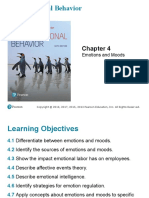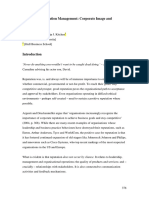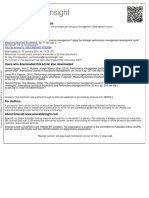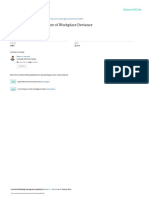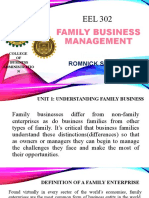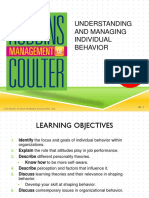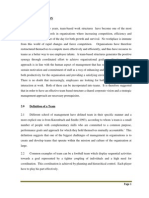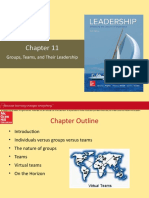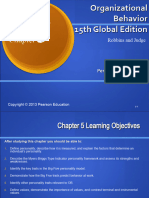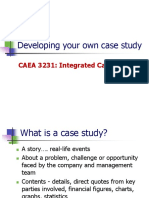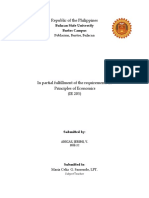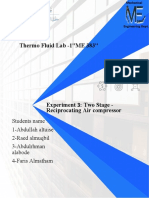Chapter
Personality and Values
5-1
�5-2
Chapter 5 Learning Objectives
After studying this chapter you should be able to:
Define personality, describe how it is measured, and explain the
1.
factors that determine an individuals personality.
Describe the Myers-Briggs Type Indicator personality framework
2.
and assess its strengths and weaknesses.
3.
Identify the key traits in the Big Five personality model.
Demonstrate how the Big Five traits predict behavior at work.
4.
Identify other personality traits relevant to OB.
5.
6.
Define values, demonstrate the importance of values, and
contrast terminal and instrumental values.
7.
Compare generational differences in values and identify the
dominant values in todays workforce.
Identify Hofstedes five value dimensions of national culture
8.
�Personality
Personality
is a dynamic concept describing the
growth and development of a persons whole
psychological system;
Defining Personality:
The sum total of ways in which an individual
reacts to and interacts with others.
5-3
�Personality
Managers
need to know how to measure personality
Personality tests are useful in hiring decisions and help
managers forecast who is best for a job.
The most common means of measuring personality is
through self-report surveys.
Observer-ratings surveys provide an independent
assessment of personality. Usually conducted by coworker or supervisor
Use both surveys for more accurate decision-making
5-4
� Heredity
Personality
refers to those factors that were determined at
conception.
Popular characteristics include shy, aggressive,
submissive, lazy, ambitious, loyal, and timid. These are
personality traits.
Personality traits of a person exhibiting frequent
similar characteristics determine the trait of that person
5-5
�Myers-Briggs Type Indicator personality framework
One
of the most widely used personality
frameworks is the Myers-Briggs Type Indicator
(MBTI).
Individuals are classified as:
Extroverted or introverted (E or I).
Sensing or intuitive (S or N).
Thinking or feeling (T or F).
Perceiving or judging (P or J).
5-6
�Understanding personality
�The Big 5!!
Extraversion
Conscientiousness
Agreeableness
Emotional
stability
Openness to new
experience
�Traits and behavior at work
Better interpersonal
skills
Higher performance
Greater social
dominance
More emotionally
expressive
Enhanced leadership
Higher job
satisfaction
Higher life
satisfaction
EXTROVERSION
�Traits and behavior at work
Increased learning
Training
performance
More creative
Enhanced leadership
More flexible and
autonomous
Adaptable to change
OPENNESS
�Traits and behavior at work
Better liked
Higher performance
More compliant and
conforming
Lower levels of
deviant behavior
AGREEABLENESS
�Traits and behavior at work
Greater effort and
persistence
Higher performance
Better organized and
planning
Greater longevity
More drive and discipline
CONSCIENTIOUSNESS
Enhanced leadership
�Traits and behavior at work
Less negative
thinking
Higher job
satisfaction
Less negative
emotions
Less hyper-vigilant
Higher life
satisfaction
Lower stress level
EMOTIONAL
STABILITY
the Big Five
The five factors appear in almost all cross-cultural studies.
Studies included a variety of diverse cultures.
Differences are complex but seem to depend on whether countries
are predominantly individualistic or collectivistic. What determine
this?
Complexity of the society
1.
2.
Affluence of the society
3.
Heterogeneity
They appear to predict a bit better in individualistic than in
collectivist cultures.
5-14
�Identify other personality traits relevant to OB
Core self-evaluation
The
degree to which
people like or dislike
themselves
Positive
self-evaluation
leads to higher job
performance
�Identify other personality traits relevant to OB
Machiavellanism (Mach)
What are they like?
A pragmatic, emotionally
distant power-player who
believes that ends justify the
means
High Machs are manipulative,
win more often, and persuade
more than they are persuaded.
Successful only when they:
Have direct interaction
Work with minimal rules and
regulations
�Identify other personality traits relevant to OB
Narcissism
An
arrogant, entitled,
self-important person
who needs excessive
admiration
Less
jobs
effective in their
�Identify other personality traits relevant to OB
Self-Monitoring
The
ability to adjust
behavior to meet
external, situational
factors.
High
monitors conform
more and are more
likely to become
leaders.
�Identify other personality traits relevant to OB
Risk Taking
The willingness to take
chances.
May be best to align
propensities with job
requirements.
Risk takers make faster
decisions with less
information.
�Identify other personality traits relevant to OB
Proactive Personality
Identifies
opportunities, shows
initiative, takes action,
and perseveres to
completion
Creates
positive
change in the
environment
�Identify other personality traits relevant to OB
Other orientation
Decisions
affected by our social influences &
concerns versus our well-being & outcomes;
e.g. pay me back vs pay me forward
� Importance
Values
of Values
Values lay the foundation for the understanding of
attitudes and motivation.
Values generally influence attitudes and behaviors.
We can predict reaction based on understanding
values.
Is values stable? Enduring?
5-22
�Dominant values in todays workforce
5-23
John Hollands Personality-Job Fit Theory
(1) Person-Job fit
6 personality
types
Vocational
preference
inventory
questionnaire
Jobs should be
congruent with
personality
Satisfaction
highest
Turnover lowest
�Personality and Values to the Workplace
5-25
�(2) Person-organization fit
People are attracted to
organizations that
match their values.
Mismatches will result
in turnover.
The employees
personality must fit
with the
organizational culture
and environment.
�Hofstedes five value dimensions of national culture
Five
value dimensions of national culture:
1. Power distance
2. Individualism versus collectivism
3. Masculinity (acquisition of money & material
goods prevail) versus femininity (value
relationships, show sensitivity/concern)
4. Uncertainty avoidance (a society's tolerance for
uncertainty and ambiguity)
5. Long-term versus short-term orientation
5-27
�Hofstedes five value dimensions of national culture
The
Global Leadership and Organizational
Behavior Effectiveness (GLOBE) began
updating Hofstedes research with data from 825
organizations and 62 countries.
Similar to Hofstedes dimension, with the
addition of:
Performance
orientation
Humane orientation
5-28
� Big
Summary and Implications
for Managers
Five provides a meaningful way for managers to
examine personality
Managers keys
Screening job candidates for high
conscientiousness
Factors such as job demands, the degree of
required interaction with others, and the
organizations culture are examples of
situational variables that moderate the
personalityjob performance relationship.
5-29
� You
Summary andImplications
for Managers
need to evaluate the job, the work group,
and the organization to determine the optimal
personality fit.
Other traits, such as core self-evaluation or
narcissism, may be relevant in certain situations,
too.
Although the MBTI has been widely criticized, it
may have a place in organizations.
5-30
� Knowledge
Summary and Implications
for Managers
of an individuals value system can
provide insight into what makes the person tick.
Employees performance and satisfaction are likely
to be higher if their values fit well with the
organization.
The person who places great importance on
imagination, independence, and freedom is likely to
be poorly matched with an organization that seeks
conformity from its employees.
5-31
� Managers
Summary and Implications
for Managers
are more likely to appreciate,
evaluate positively, and allocate rewards to
employees who fit in, and employees are more
likely to be satisfied if they perceive they do fit in.
This argues for management to seek job
candidates who have not only the ability,
experience, and motivation to perform but also a
value system compatible with the organizations.
5-32





